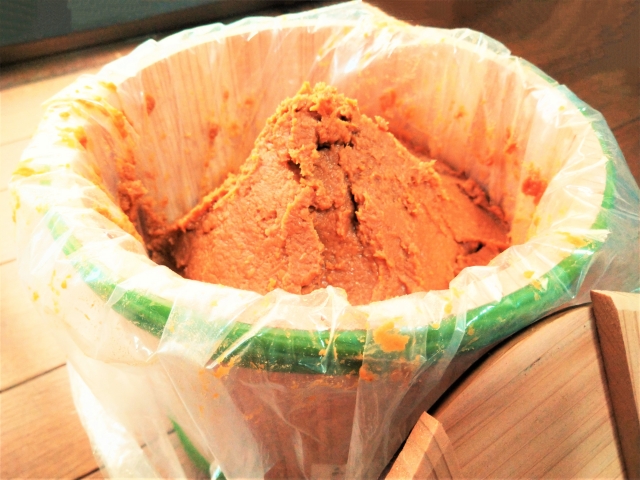If you’ve ever enjoyed a bowl of miso soup or tasted a rich miso glaze on grilled fish, you’ve encountered one of Japan’s most iconic fermented foods. But miso is more than just a seasoning — it’s a cultural symbol, a nutritional powerhouse, and a product deeply rooted in Japan’s diverse history and regions.
A Fermented Tradition
Miso is a paste made by fermenting soybeans with salt and kōji. Depending on the ingredients used and the fermentation period, miso can range from sweet and light to dark and intensely savory. Its umami depth has made it a beloved ingredient not only in soups but also marinades, dressings, pickles, and even desserts.
Samurai and Miso: The Warrior’s Food
Interestingly, miso played a key role in Japanese military history. During the Sengoku period (around 15~17th century), miso was carried as part of the soldiers’ provisions. Known for its long shelf life and high nutritional value, miso was used as a vital source of sustenance in the battlefield. Some warlords even developed their own signature miso types to feed their armies — for example, Takeda Shingen is said to have valued miso highly for his troops.
Regional Flavors Across Japan
One of the most fascinating things about miso is its regional diversity. Just like wine in France or cheese in Italy, miso varies dramatically from one place to another:
- Hatcho Miso (Aichi): A very dark, aged miso made only from soybeans and salt, known for its robust flavor.
- Shinshu Miso (Nagano): A yellowish, mildly salty miso made from rice koji, popular across Japan.
- Sendai Miso (Tohoku region): A reddish-brown miso with a hearty, bold taste.
- Saikyo Miso (Kyoto): A sweet white miso with a short fermentation time, often used in elegant Kyoto-style dishes (京料理 kyo-ryori).
Even within a single region, households may have their own preferred blends or even make homemade miso, preserving unique family traditions.
Miso used to be something your granny makes at your home. Like kimchi in Korea, the tradition is decreasing in number, but you can still try and make your original miso!
Not Just Soybeans: The Variety of Ingredients
While soybeans are the most common base for miso, other grains and ingredients are also used:
- Rice Miso (Kome Miso): Made with rice koji, the most common type.
- Barley Miso (Mugi Miso): Made with barley koji. Popular in western Japan, often sweeter and more rustic.
- Soybean Miso (Mame Miso): Made with 100% soybeans (which is made into soybean koji) and a longer fermentation time for a deep, concentrated flavor.
These variations not only affect the taste and color but also reflect local agricultural conditions and cultural preferences.
For example, western Japan is famous for softer water compared to eastern Japan. Umami from dashi(such as kelp, dried bonito flake, dried mushrooms and so on) is more prominent in softer water, which leads to less salinity in miso itself. When you make miso soup, you add both dashi and miso, and if your water is very soft, you wouldn’t need much salt from miso to enjoy the taste!
Blending Miso: A Personal Touch to Flavor
One of the most enjoyable aspects of using miso in cooking is discovering your own favorite blend. Mixing different types of miso — such as a mellow white miso with a bold red miso — creates a deeper, more complex flavor that can be customized to suit your dish or personal taste. Currently, I’m mixing white mugi miso and a little bit of red miso for my miso soup.
Some home cooks in Japan create their own awase miso (blended miso), combining varieties like rice miso and barley miso, or balancing sweetness and saltiness. It’s a bit like crafting your own spice mix — deeply personal and endlessly creative. Once you start experimenting, you may find a blend that becomes your signature flavor!
A Living Food with Modern Appeal
Miso continues to gain popularity worldwide for its health benefits — it’s packed with probiotics, minerals, and antioxidants. It also supports gut health, making it a favorite among those interested in fermented foods and chōkatsu (gut wellness).
And like many other fermented foods, miso is a “living” ingredient — when unpasteurized, it still contains beneficial microbes that evolve over time.
Miso is limitless!
Miso is not just a pantry item; it’s a window into Japan’s regional culture, culinary history, and creative spirit. Whether you enjoy it in a simple soup, a rich marinade, or your own blended creation, miso offers layers of flavor and tradition that continue to evolve with every cook who uses it.
In a future post, I’d love to share how I make my own miso at home — and how surprisingly simple (and satisfying!) the process can be.


